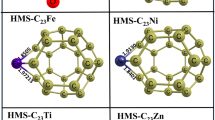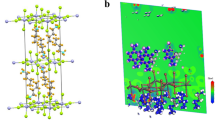Abstract
In this study, density functional theory calculations were carried out to investigate the adsorption of NH3 gas on the pristine and B- and Al-doped hexa-peri-hexabenzocoronenes (HBCs). The results indicated that the adsorption of NH3 molecule on pristine HBC is quite weak, while both B- and Al-doped HBCs can strongly adsorb NH3 molecule. The significant increase in band gap was observed in the B-doped HBCs, which confirms the high sensitivity of the B-doped HBCs towards NH3 molecule. Also, our calculations show that pristine HBC cannot detect the presence of NH3 gas. The nature of interactions was characterized by the non-covalent interaction (NCI) and quantum theory of atoms in molecules (QTAIM) analyses. Based on the overall results, B-doped HBCs are promising candidates for sensing ammonia molecules.



Similar content being viewed by others
References
Dikin DA, Stankovich S, Zimney EJ, Piner RD, Dommett GH, Evmenenko G, Nguyen ST, Ruoff RS (2007) Preparation and characterization of graphene oxide paper. Nature 448:457
Zhu Y, Murali S, Cai W, Li X, Suk JW, Potts JR, Ruoff RS (2010) Graphene and graphene oxide: synthesis, properties, and applications. Adv Mater 22:3906–3924
Yao B, Wu Y, Zhang A, Rao Y, Wang Z, Cheng Y, Gong Y, Zhang W, Chen Y, Chiang K (2014) Graphene enhanced evanescent field in microfiber multimode interferometer for highly sensitive gas sensing. Opt Express 22:28154–28162
Prezioso S, Perrozzi F, Giancaterini L, Cantalini C, Treossi E, Palermo V, Nardone M, Santucci S, Ottaviano L (2013) Graphene oxide as a practical solution to high sensitivity gas sensing. J Phys Chem C 117:10683–10690
Yuan W, Liu A, Huang L, Li C, Shi G (2013) High-performance NO2 sensors based on chemically modified graphene. Adv Mater 25:766–771
Ren W, Mura S, Irudayaraj JM (2015) Modified graphene oxide sensors for ultra-sensitive detection of nitrate ions in water. Talanta 143:234–239
Park M-S, Kim KH, Kim M-J, Lee Y-S (2016) NH3 gas sensing properties of a gas sensor based on fluorinated graphene oxide. Colloids Surf A Physicochem Eng Asp 490:104–109
Chatterjee SG, Chatterjee S, Ray AK, Chakraborty AK (2015) Graphene–metal oxide nanohybrids for toxic gas sensor: a review. Sensors Actuators B Chem 221:1170–1181
Sun KG, Hur SH (2015) Highly sensitive non-enzymatic glucose sensor based on Pt nanoparticle decorated graphene oxide hydrogel. Sensors Actuators B Chem 210:618–623
Nayak JK, Parhi P, Jha R (2015) Graphene oxide encapsulated gold nanoparticle based stable fibre optic sucrose sensor. Sensors Actuators B Chem 221:835–841
Wu J, Pisula W, Müllen K (2007) Graphenes as potential material for electronics. Chem Rev 107:718–747
Cappelli E, Orlando S, Servidori M, Scilletta C (2007) Nano-graphene structures deposited by N-IR pulsed laser ablation of graphite on Si. Appl Surf Sci 254:1273–1278
Krieg M, Reicherter F, Haiss P, Ströbele M, Eichele K, Treanor MJ, Schaub R, Bettinger HF (2015) Construction of an internally B3N3-doped nanographene molecule. Angew Chem Int Ed 54:8284–8286
Narita A, Wang X-Y, Feng X, Müllen K (2015) New advances in nanographene chemistry. Chem Soc Rev 44:6616–6643
Jang BZ, Zhamu A (2008) Processing of nanographene platelets (NGPs) and NGP nanocomposites: a review. J Mater Sci 43:5092–5101
Chen L, Hernandez Y, Feng X, Müllen K (2012) From nanographene and graphene nanoribbons to graphene sheets: chemical synthesis. Angew Chem Int Ed 51:7640–7654
Liu X-T, Guo J-F, Ren A-M, Huang S, Feng J-K (2012) Nonlinear optical properties for a class of hexa-peri-hexabenzocoronene chromophores: a computational investigation. Dalton Trans 41:12416–12427
Keerthi A, Hou ICY, Marszalek T, Pisula W, Baumgarten M, Narita A (2016) Hexa-peri-hexabenzocoronene with different acceptor units for tuning optoelectronic properties. Chem Asian J 11:2710–2714
Tönshoff C, Müller M, Kar T, Latteyer F, Chassé T, Eichele K, Bettinger HF (2012) B3N3 Borazine substitution in hexa-peri-hexabenzocoronene: computational analysis and scholl reaction of hexaphenylborazine. ChemPhysChem 13:1173–1181
Li Z, Lin Z, Wang N, Wang J, Liu W, Sun K, Fu YQ, Wang Z (2016) High precision NH3 sensing using network nano-sheet Co3O4 arrays based sensor at room temperature. Sensors Actuators B Chem 235:222–231
Zhang Y-H, Chen Y-B, Zhou K-G, Liu C-H, Zeng J, Zhang H-L, Peng Y (2009) Improving gas sensing properties of graphene by introducing dopants and defects: a first-principles study. Nanotechnology 20:185504
Beheshtian J, Peyghan AA, Bagheri Z (2013) Carbon nanotube functionalization with carboxylic derivatives: a DFT study. J Mol Model 19:391–396
Zhao C, Jiao Y, Hu F, Yang Y (2017) Green synthesis of carbon dots from pork and application as nanosensors for uric acid detection. Spectrochim Acta, Part A
Jameh-Bozorghi S, Soleymanabadi H (2017) Warped C80H30 nanographene as a chemical sensor for CO gas: DFT studies. Phys Lett A 381:646–651
Bhatia S, Verma N, Bedi R (2017) Ethanol gas sensor based upon ZnO nanoparticles prepared by different techniques. Results Phys 7:801–806
Timmer B, Olthuis W, Van den Berg A (2005) Ammonia sensors and their applications—a review. Sensors Actuators B Chem 107:666–677
Ugale AD, Jagtap RV, Pawar D, Datar S, Kale SN, Alegaonkar PS (2016) Nano-carbon: preparation, assessment, and applications for NH3 gas sensor and electromagnetic interference shielding. RSC Adv 6:97266–97275
Vatanparast M, Nekoei A-R (2015) RAHB concept and σ-skeleton in some oximes of 3-hydroxy fulvene; DFT, AIM, ELF and NBO studies. Struct Chem 26:1039–1048
Nekoei AR, Vatanparast M (2014) An intramolecular hydrogen bond study in some Schiff bases of fulvene: a challenge between the RAHB concept and the σ-skeleton influence. New J Chem 38:5886–5891
Vatanparast M (2014) Cooperativity between the halogen bonding and halogen–hydride bonding in NCX⋯ NCX⋯ HMgY complexes (X= F, Cl, Br; Y= H, F, Cl, Br, CH 3, Li). Comput Theor Chem 1048:77–83
Vatanparast M, Taghizadeh MT, Parvini E (2015) Theoretical insight into the interplay between lithium and halogen–hydride bonds: an ab initio study. J Theor Comput Chem 14:1550046
Parvini E, Vatanparast M, Saedi L (2017) Ab initio studies on the interplay between unconventional B•••X halogen bond and lithium/hydrogen/halogen bond in HB (CO)2•••XCN••• YF (X= Cl, Br; Y= Li, H, Cl) complexes. Phys Chem Res 5:771–781
Bahrami A, Yourdkhani S, Esrafili MD, Hadipour NL (2014) A DFT study on doping assisted changing of B80 electronic structure: promising candidates for NH3 sensor. Sensors Actuators B Chem 191:457–463
Baei MT, Tavakoli K, Hashemian S, Torabi P (2015) C30B15N15 heterofullerene as a potential electronic sensor for NO detection. Fullerenes, Nanotubes, Carbon Nanostruct 23:153–157
Fan G-h, Zhu S, Li X-k, Ni K, Xu H (2017) Ab initio investigation of pristine and doped single-walled boron nitride nanotubes as acetone sensor. Comput Theor Chem 1115:208–216
Saadat K, Tavakol H (2016) Study of noncovalent interactions of end-caped sulfur-doped carbon nanotubes using DFT, QTAIM, NBO and NCI calculations. Struct Chem 27:739–751
Baei MT, Peyghan AA, Bagheri Z (2013) Carbon nanocone as an ammonia sensor: DFT studies. Struct Chem 24:1099–1103
Nagarajan V, Chandiramouli R (2014) NiO nanocone as a CO sensor: DFT investigation. Struct Chem 25:1765–1771
Azizi K, Karimpanah M (2013) Computational study of Al- or P-doped single-walled carbon nanotubes as NH3 and NO 2 sensors. Appl Surf Sci 285:102–109
Frisch MJ, Trucks GW, Schlegel HB, Scuseria GE, Robb MA, Cheeseman JR, Montgomery JA, Vreven T, Kudin KN, Burant JC, Millam JM, Iyengar SS, Tomasi J, Barone V, Mennucci B, Cossi M, Scalmani G, Rega N, Petersson GA, Nakatsuji H, Hada M, Ehara M, Toyota K, Fukuda R, Hasegawa J, Ishida M, Nakajima T, Honda Y, Kitao O, Nakai H, Klene M, Li X, Knox JE, Hratchian HP, Cross JB, Bakken V, Adamo C, Jaramillo J, Gomperts R, Stratmann RE, Yazyev O, Austin AJ, Cammi R, Pomelli C, Ochterski JW, Ayala PY, Morokuma K, Voth GA, Salvador P, Dannenberg JJ, Zakrzewski VG, Dapprich S, Daniels AD, Strain MC, Farkas O, Malick DK, Rabuck AD, Raghavachari K, Foresman JB, Ortiz JV, Cui Q, Baboul AG, Clifford S, Cioslowski J, Stefanov BB, Liu G, Liashenko A, Piskorz P, Komaromi I, Martin RL, Fox DJ, Keith T, Laham A, Peng CY, Nanayakkara A, Challacombe M, Gill PMW, Johnson B, Chen W, Wong MW, Gonzalez C, Pople JA (2003) Gaussian 03, revision B03. Gaussian, Inc, Pittsburgh
Boys SF, Bernardi F (1970) The calculation of small molecular interactions by the differences of separate total energies. Some procedures with reduced errors. Mol Phys 19:553–566
Glendening ED, Reed AE, Carpenter JE, Weinhold F (1995) NBO version 31
Biegler Konig FW, Schonbohm J, Bayles D (2001) AIM2000. J Comput Chem 22:545–559
Lu T, Chen F (2012) Multiwfn: a multifunctional wavefunction analyzer. J Comput Chem 33:580–592
O'Boyle NM, Tenderholt AL, Langner KM (2008) cclib: a library for package-independent computational chemistry algorithms. J Comput Chem 29:839–845
Hadipour NL, Ahmadi Peyghan A, Soleymanabadi H (2015) Theoretical study on the Al-doped ZnO nanoclusters for CO chemical sensors. J Phys Chem C 119:6398–6404
Breuer T, Klues M, Liesfeld P, Viertel A, Conrad M, Hecht S, Witte G (2016) Self-assembly of partially fluorinated hexabenzocoronene derivatives in the solid state. Phys Chem Chem Phys 18:33344–33350
Dai Y, Li Z, Yang J (2015) A density functional study of the nonlinear optical properties of edge-functionalized nonplanar nanographenes. ChemPhysChem 16:2783–2788
Maghsoumi A, Narita A, Dong R, Feng X, Castiglioni C, Müllen K, Tommasini M (2016) Edge chlorination of hexa-peri-hexabenzocoronene investigated by density functional theory and vibrational spectroscopy. Phys Chem Chem Phys 18:11869–11878
Salari AA (2017) Detection of NO2 by hexa-peri-hexabenzocoronene nanographene: a DFT study. C R Chim
Vessally E, Soleimani-Amiri S, Hosseinian A, Edjlali L, Bekhradnia A (2017) A comparative computational study on the BN ring doped nanographenes. Appl Surf Sci 396:740–745
Yamaguchi R, Ito S, Lee BS, Hiroto S, Kim D, Shinokubo H (2013) Functionalization of hexa-peri-hexabenzocoronenes: investigation of the substituent effects on a superbenzene. Chem Asian J 8:178–190
Johnson ER, Keinan S, Mori-Sánchez P, Contreras-García J, Cohen AJ, Yang W (2010) Revealing noncovalent interactions. J Am Chem Soc 132:6498–6506
Author information
Authors and Affiliations
Corresponding author
Ethics declarations
Conflict of interest
The authors declare that they have no conflict of interest.
Ethical approval
This article does not contain any studies with human participants or animals performed by any of the authors. The manuscript has not been previously published, is not currently submitted for review to any other journal, and will not be submitted elsewhere before a decision is made by this journal.
Rights and permissions
About this article
Cite this article
Javadi, N., Vatanparast, M. Potential application of doped hexa-peri-hexabenzocoronene as NH3 gas sensor: a computational investigation. Struct Chem 29, 929–935 (2018). https://doi.org/10.1007/s11224-018-1076-6
Received:
Accepted:
Published:
Issue Date:
DOI: https://doi.org/10.1007/s11224-018-1076-6




